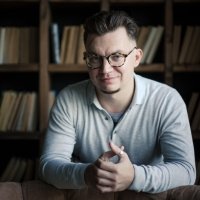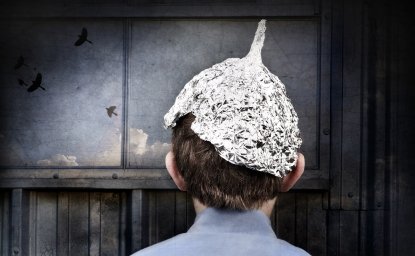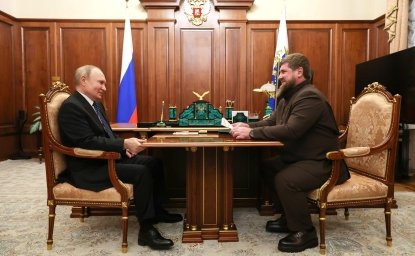
A blog of the Kennan Institute
I won’t deny it: it feels good when your forecasts come true. You feel triumphant when what you’ve been saying and writing proves to be true. You rejoice when years of hard work culminate in correct conclusions. After all, social scientists rarely manage to predict the future. And yet, some forecasts become a nightmarish reality you would prefer to wake up from. This is exactly my case.
My book Russian Conspiracy Culture was published in 2020, in the midst of the coronavirus pandemic. Its English-language version, Fortress Russia: Conspiracy Theories in the Post-Soviet World, had come out two years earlier, in the summer of 2018. The book is a product of almost 10 years of research and reflection on the place of conspiracy theories in Russian society. Everything I wanted to say in these two books boils down to one rather simple idea: Russian society is saturated with conspiracy thinking, and everyone—from a vehement anti-Putinist to a subscriber of Igor Girkin (Strelkov) on social media, from a low-level staffer of the United Russia Party office in Kaluga to the head of Russian special services—believes in conspiracy theories.
In part, this is natural, and in part, this is a result of years of methodical propaganda: endless YouTube videos, loudmouthed radio DJs, pseudohistorical literature, incredibly vulgar talk shows, and court conspirologists like former Minister of Culture Vladimir Medinsky. The transformation of this ubiquitous propaganda into political action is a dangerous trend, but in the past, the Russian regime only employed this tool in times of crisis. After each crisis, things went back to normal.
By the late 2010s, the belief that “everything happens for a reason” became mainstream. People stopped being embarrassed by it and got used to seeing someone’s ill will behind events. After the spring of 2020, I got involved in other projects, but by summer 2021, I realized just how deeply conspirological mistrust of the “system” had penetrated the Russian cultural DNA. Anti-vaxxers’ protests and calls to overthrow the anti-people government that wanted to microchip everyone spelled disaster for the Kremlin’s propaganda. It’s impossible to keep sowing mistrust and hope that you will be trusted.
Then came Black February of 2022. An hour-long lecture by Vladimir Putin about Ukraine being an imaginary state and NATO preparing a foothold to attack Russia in Ukraine meant one thing: conspiracy thinking, like cancer, had penetrated the highest echelons of Russian political hierarchy. There is no doubt that Putin’s world is a perfect mythological virtual reality made up of intelligence reports, fragments of propagandist military conspiracy porn, and Cold War veterans’ stereotypes. Putin’s September 30 speech only served to confirm that his sole concern, from that point on, was war against the entire world, and that overturning the American anti-Russian conspiracy was a matter of honor.
Obliging political analysts and journalists eagerly fuel this fire with new ideas. Thousands of pro-Kremlin Telegram channels, sponsored by the Russian presidential administration and friendly oligarchs, post around the clock about “Ukrainian fascism,” “cancellation of Russia,” and “global information war,” invoking the West’s double and even triple standards. The average social media user, for whom Ukraine, the European Union, and—especially—the United States are entirely virtual entities, which he or she has never visited and most likely never will, has fallen into the trap of anti-Western propaganda, gradually internalized conspiralogical templates, and starts passing them on to others. This has been the information diet of the average Russian citizen over the past six months. What does it include? Let’s talk about some of its key ingredients.
Conspiracy theories can be roughly divided into two categories: systemic, which are linked to Kremlin ideology that took shape in the 2010s, and situational, which are tied to specific developments on the front lines and at home that require immediate interpretation. Entire talk shows may focus on the latter, but a couple of weeks later no one discusses them anymore. Propaganda follows the logic of the news cycle, jumping from topic to topic and quickly forgetting that which seemed critically important only a moment ago. Good examples of situational conspiracy theories are speculations about who killed Daria Dugina and who blew up the Nord Stream pipeline.
Systemic conspiracy theories are easier to deal with. The central underlying conspiracy theory is that the West, with its 100 faces and manifestations, is waging a millennium-old war against Russia. Russia’s attempt at a blitzkrieg in Ukraine was an attempt to defend against NATO’s creeping tentacles. The West intends to use NATO to isolate Russia, then “cancel” and destroy it, taking its natural resources and slaughtering 100 million Russians. “The official Russophobia in the West has reached an unprecedented, grotesque scale,” Russian Foreign Minister Sergey Lavrov told the UN. “Over there they are no longer shying away from declaring that they intend to inflict military defeat upon our country but also to destroy and fracture Russia,” in order to “remove from the global map a geopolitical entity that has become all too independent.” Lavrov, at that moment, resembled both Nikita Khrushchev and Mahmoud Ahmadinejad, with their passionate anti-American rants.
And this is what Putin himself said on September 30: “Western elites not only deny national sovereignty and international law. Their hegemony has pronounced features of totalitarianism, despotism, and apartheid. They brazenly divide the world into their vassals—the so-called civilized countries—and all the rest, who, according to the designs of today’s Western racists, should be added to the list of barbarians and savages.” Initially performative and flippant, repeated with a smirk at various international summits since 2007, this accusation against the West has become the only way for Putin to mobilize the Russian people and frighten them into believing that, once his regime collapses, foreign colonizers will invade, turn families into “parent number one” and “parent number two,” microchip everyone, and force Russians to forget the glorious victories of the past. In fact, the “colonizers” are already here: Ekaterina Mizulina and her Safe Internet League claims to catch millions of online “fakes” and that “Western IT giants encourage the spread of trash and negative content inside the internet.” She estimates that the price of this anti-Russian conspiracy is 1.5 billion roubles.
This season, the “collective West’s” primary weapon in this centuries-old standoff with Russia is Ukraine (the “Kyiv regime” in Russian parlance, which has supposedly seized power in Ukraine as a result of an armed coup supported by the United States.) Conspiracy theorist Nikolai Starikov, the favorite guest of Russian state television talk shows, wrote on his Telegram channel that “Ukraine is not just anti-Russia. It is the world behind the looking glass. Some sort of madness and delusion.” When announcing the “partial mobilization,” Defense Minister Sergey Shoigu claimed that Russia was waging a war on the “collective West,” rather than Ukraine. “Ukraine’s only goal is to turn Russians into non-Russians, into anti-Russians. And drown Eurasia in blood,” frantically repeats Starikov, commenting on Putin’s meeting with school students on September 1. Presenting Ukraine as a tool, depriving the people and leaders of Ukraine of their agency, by, for instance, using the words “Kyiv regime,” serves to belittle the entire nation. It also minimizes the role of Ukrainians in their own military victories.
In general, conspiracy theories give a simple answer to the question about who holds power in a society. If Russia is so strong and successful, as its leaders claim, why is everything they touch, from warfare to mobilization, falling apart? Either the system is rotten to the core, or there is a massive conspiracy. Here, for instance, is a social media post by Andrey Medvedev, a well-known crime reporter from the 1990s, claiming that Western intelligence services have recruited people at military enlistment offices all around Russia, setting the stage for social instability. Here you go then: faced with uncertainty, use a conspiracy theory, as nothing else will bring clarity to the chaos and nightmare around you with the same speed and efficiency.
Conspiracy theories also have an in-built protective function. Their proliferators are always prepared to explain who is guilty, find a scapegoat, or generate confusion by flooding the audience with multiple versions of events, with varying degrees of insanity. According to them, the Bucha massacre, the missile strike against Kremenchug, and the bombings of Mariupol have all been staged by the “Kyiv regime,” because there are “too many inconsistencies.” They claim the evidence to be fake and meant to tarnish the reputation of the Russian army and its “glorious” mission, so everyone spreading this “fake news” ought to be jailed. The atmosphere of post-truth carefully fostered in Russia since the 1990s is a perfect setting for making sure that millions of consumers of pro-government content rely on conspiracy theories to protect themselves from the horrors of the war in Ukraine, so much so that they phone their Ukrainian relatives to explain that it was neo-Nazis who bombed Mariupol. In this context, claims along the lines of “fully dependent on its Western puppeteers, the Ukrainian regime is ready to commit any crime” become therapeutic for many people. They will awaken to the horrors of reality, but only much later.
Finally, by trying opportunistically to engage the anti-vax segment of the audience, the Russian defense ministry generated a customized conspiracy theory last March. According to it, biolabs in Eastern Ukraine developed coronaviruses and planned to trigger a new epidemic by using birds to infect Russians. Furthermore, these labs carried out secret experiments that turned Ukrainian soldiers into horrible monsters, and this must be the real reason for the Russian army’s lack of progress. But these conspiracy theories were rather short-lived. Two weeks later, they disappeared from the news agenda. They never even made it to the COVID conspiracist Telegram channels.
Still, there are two pieces of good news: every bit of propaganda has its limits, and truly hardcore conspiracy theorists are rare. Most people will, of course, use conspiracy theories to protect themselves from painful truths, but turning off the government-sponsored industry of lies will help bring many of them back to reality. However, conspiracy theories are a universal phenomenon that one can encounter in any political regime, which emerge when society deals with conflicts and crises. Post-Putin Russia will likely face many of those, and there will be actors tempted to learn from Putinism and make use of this propaganda tool.
The article originally appeared in Russian on Иными словами, a Kennan Institute Blog.
The opinions expressed in this article are those solely of the author and do not reflect the views of the Kennan Institute.
Author


Kennan Institute
The Kennan Institute is the premier US center for advanced research on Eurasia and the oldest and largest regional program at the Woodrow Wilson International Center for Scholars. The Kennan Institute is committed to improving American understanding of Russia, Ukraine, Central Asia, the South Caucasus, and the surrounding region through research and exchange. Read more

Explore More in The Russia File
Browse The Russia File
Теория большого заговора

Chechnya as a Model of Modern Russia

Russia’s Indigenous Communities and the War in Ukraine

